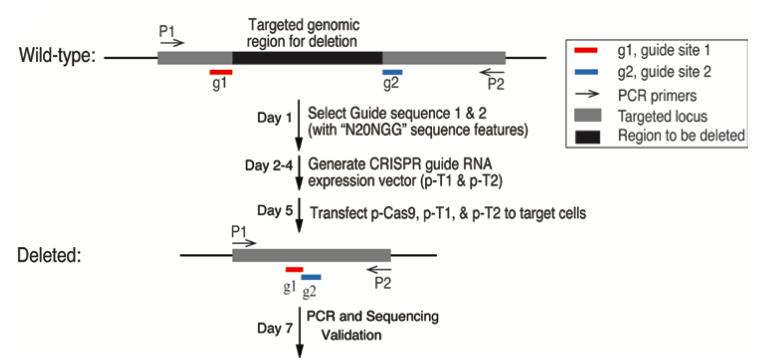Gene Deletion
An Overview
Deletion means that something is missing. In genetics, a deletion (also called gene deletion) means that a mutation has occurred that a part of chromosome or a sequence of DNA is deleted during DNA replication. Any number of nucleotides can be possibly deleted, from a single base to an entire piece of chromosome.
If you want to know whether there is a deletion in a chromosome, you need to do a cytogenetic or chromosome analysis, or a deletion in a gene and you can sequence the targeted DNA to identify. Different deletions lead to different results, and they can affect just behavior; they can affect how a child, how a person looks; they can lead to the child may die at birth; or they can vary something that just has to do with eye color, hair color, with weight or height of the person.
Examples of Deletion
Gene deletion can be divided into two parts, point and chromosome deletions during DNA replication.
- Point deletion
In a point mutation, an error occurs in a single nucleotide. The entire base pair may be missing, or just the nitrogenous base on the master strand. For point deletions, one nucleotide has been deleted from the sequence. For instance, if the original sequence is ATG-AGT-CGT-ATA-TAA, it will code for methionine, serine, arginine, isoleucine, and finally the STOP codon (telling the cell to stop protein production). By a point deletion, the new sequence is ATG-AGC-GTA-TAT-AA. Among the sequence, a T is deleted. It will code for methionine, serine, valine, tyrosine, and then the final AA doesn't code for anything.
- Chromosome deletion
A chromosome deletion means that a whole section of a chromosome is deleted. This deletion can involve any number of base pairs. Sometimes an entire chromosome can be deleted as well. Whenever any DNA is deleted during replication, any number of genetic diseases can occur.
Why Harmful?
Gene deletion results in a frame-shift that varies the reading of subsequent codons and, therefore, changes the entire amino acid sequence that follows the mutation. Deletions can be caused by errors in chromosomal crossover during meiosis, which causes many serious genetic diseases, such as 22q11.2 deletion syndrome and cystic fibrosis. 22q11.2 deletion syndrome (CATCH22) is a disorder caused by the deletion of small piece of chromosome 22. Cystic fibrosis is caused by a point deletion.
Applications of Gene Deletion
Although gene deletion is harmful as described above, the technology of gene deletion is a powerful tool to help scientists to research gene functions. Small deletions may remove one or a few base pairs within a gene, while larger deletions can remove an entire gene or several neighboring genes. Therefore, the deleted DNA may alter the function of the resulting protein(s). This is the reason why gene deletion becomes one of the most powerful tools to study gene functions.
Gene Deletion by CRISPR/Cas9 System
The prokaryotic type II CRISPR/Cas9 system effectively generated targeted deletions of varied length, regardless of the transcriptional status of the target gene. It is important that targeted gene deletions altered via CRISPR/Cas9 and two guide RNAs result in the formation of correct junctions at high efficiency. What's more, in the presence of a homology repair donor, the CRISPR/Cas9 system is able to guide precise gene replacement.
 Figure 1. The steps of targeted gene deletion with CRISPR/Cas9. (Zheng, 2015)
Figure 1. The steps of targeted gene deletion with CRISPR/Cas9. (Zheng, 2015)
Reference
- Zheng, Q.; et al. (2015). Precise gene deletion and replacement using the CRISPR/Cas9 system in human cells. Biotechniques. 57(3):115-124. Distributed under Open Access license CC BY 4.0, without modification.
